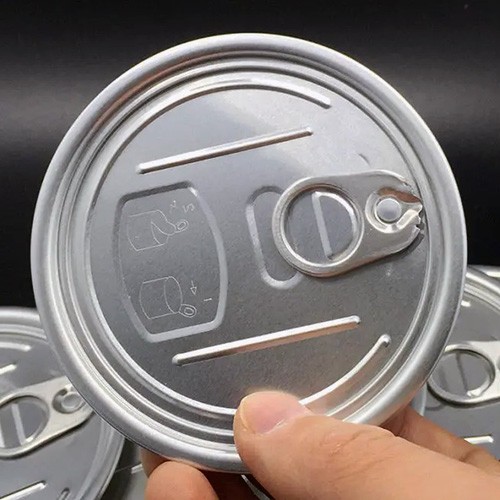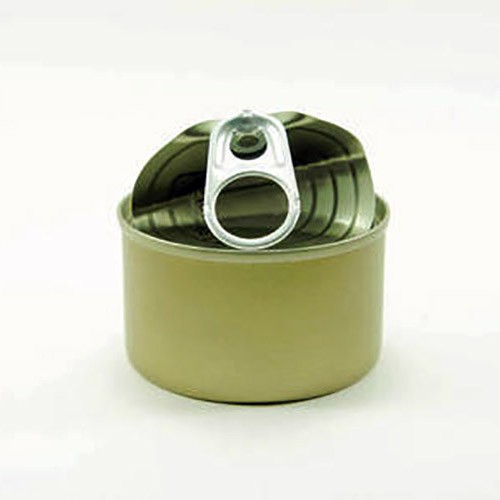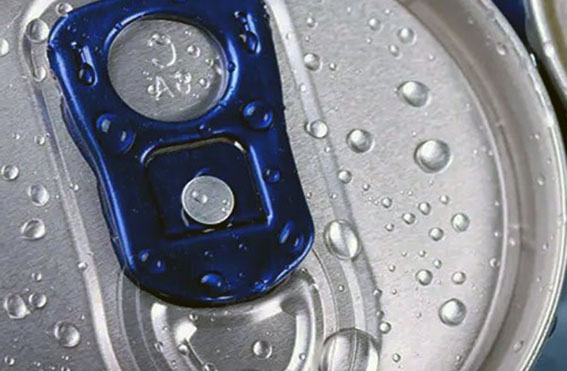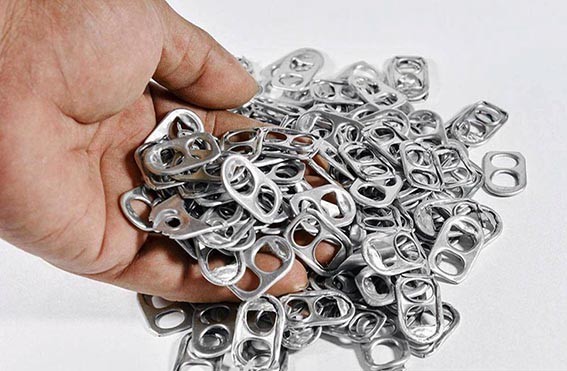3104 5052 5182 Aluminum Coil for Beverage Can Body End Tab
Last Updated :May. 21, 2024
Beverage can structure
Metal cans are divided into two-piece cans and three-piece cans according to their structure.
1. Two-piece beverage can
- Structure: Two-piece cans are composed of two parts: the can lid and the seamless can body that is integrated with the bottom. This means that the bottom and side walls of the tank are one piece, while the top is a separate lid. Typically, there will be a crimp between the tank body and lid to strengthen the connection and provide a seal.
- Features: This structure is simple, the production process is relatively easy, and the cost is relatively low. The manufacturing process of the two-piece can makes the bottom of the can more solid, suitable for carrying liquid beverages.
2. Three piece beverage can
- Structure: Three-piece cans are composed of three separate parts: the can body, the bottom and the lid. The tank body is the main part, which is composed of side walls and top. The bottom of the tank is the closed bottom part, and the lid is used to cover the top. This structure allows the can body, bottom and lid to be manufactured independently and combined together during assembly.
- Features: The manufacturing process of three-piece cans is relatively complex, but provides more design flexibility. For example, texture or patterns can be added to the can to increase the appeal of the product. In addition, the independent manufacturing of the can body, bottom and lid makes it easier to customize the bottom and lid to suit different product needs and market trends.
Both structures have their own advantages and disadvantages, and choosing the appropriate structure depends on factors such as product demand, production technology, and market positioning.
What alloys are there for aluminum beverage cans?
The types of alloys generally used in the production of aluminum cans include 3104 alloy, 3105 alloy, 5052 alloy, 5182 alloy, etc.
The main materials of aluminum coils for beverage cans include 5182 alloy coils for pull rings, 3104 coils for can bodies, and 5052 5182 alloy coils for can lids.
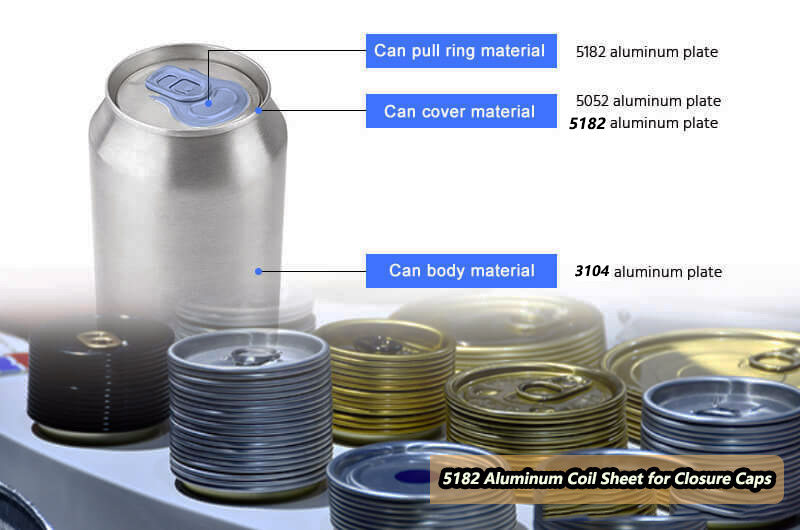
Specification Parameters Of Aluminum Sheet/Coil For Cans
| Alloy | 3104,3105,5042,5052,5182 |
| Temper | H18,H19,H48 |
| Thickness | 0.2-0.35mm(commen 0.270mm,0.280mm) |
| Thickness Tolerance | ±0.005mm |
| Width | 800-1730mm(commen 1600mm,1700mm) |
| Application | 3104/3105 H18/H19 for cans body,3104/5052/5182 H48 for cans lid |
5182 H19 H48 H49 Aluminum coils for ring-pull or Tab
5182 alloy coil is used to produce ring-pull or tab on beverage cans. These parts are essential for opening and closing the can easily. The strength and durability of 5182 alloy ensures that the pull tab can withstand repeated use without failure.
- Thickness: 0.279mm 0.287mm 0.292mm MAX 0.45mm (+/-0.003mm)
- Width: Made according to customer order (+1.5mm--0mm)
- UTS (MPa): 330-365
- TYS (MPa): 380-420
- Coating: PPG, Akzo, Valspar
- Standards: EN 541 and EN 573-3
- Roll weight: 2500kgs-3500kgs per roll
5052 5182 H19 H48 H49 Aluminum coils for aluminum end
5052 and 5182 alloy coils, under different tempering conditions, are used to make the ends of beverage cans. These ends are stamped and formed into the necessary shape and size to securely seal the can, protect the contents and preserve freshness.
5182 H48 aluminum alloy is stronger than 5052 H48, so 5182 H48 is mostly used for beverage lids with internal pressure, while 5052 H48 is used for beverage and food lids without internal pressure.
- Thickness: 0.208mm 0.216mm 0.224mm 0.249mm Maximum thickness 0.3mm (+/-0.003mm)
- Width: Made according to customer order (processed by slitting device) (+1.5mm--0mm)
- UTS (MPa): 330-365
- TYS (MPa): 380-420
- Coating: PPG, Akzo, Valspar, inner coating is 12-13um EPOXY, outer coating is 4-5um EPOXY.
- Roughness: 35-50um
- Standards: EN 541 and EN 573-3
- Roll weight: 2500kgs-3500kgs per roll
- The surface is treated with electrostatic spray wax
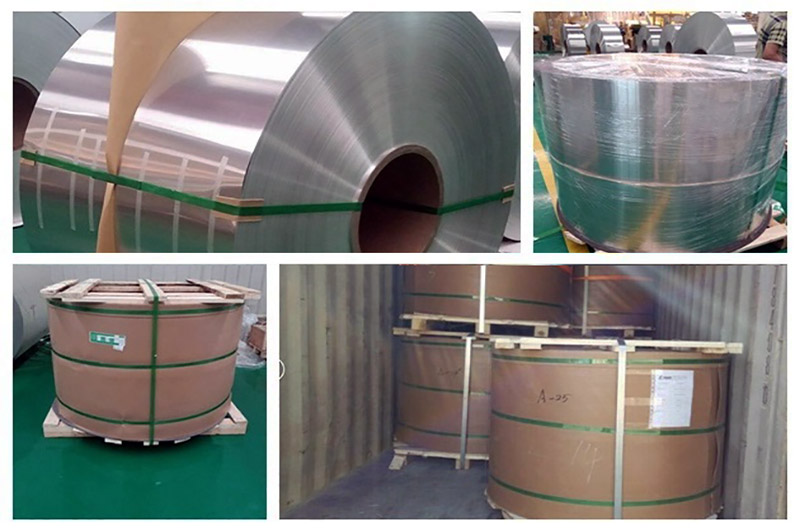
3104 Aluminum coils for aluminum can body
Alloy 3104 is designed specifically for the manufacture of beverage can bodies. The roll is processed into a sheet, which is then formed into the cylindrical shape of the tank. The corrosion-resistant properties of 3104 ensure that the can maintains its integrity even when in contact with the beverage it contains.
- Thickness: 0.2-0.28mm Customized order by customer (+/-0.003mm)
- Width: Made according to customer order (processed by slitting device) (+1.5mm--0mm)
- UTS (MPa): 265-290
- TYS (MPa): 290-330
- Roughness:40-55um
- Roll weight: 7000kgs--12000kgs
- Application: Beverage cans, beer cans, juice, etc.
3104 5052 5182 Aluminum Coil for Beverage Canchemical Composition
| Alloy | 3104 | 5052 | 5182 |
| Si | 0.6 | 0.25 | 0.2 |
| Fe | 0.8 | 0.4 | 0.35 |
| Cu | 0.05~0.25 | 0.1 | 0.15 |
| Mn | 0.8~1.4 | 0.1 | 0.2-0.5 |
| Mg | 0.8~1.3 | 2.2~2.8 | 4.0-5.0 |
| Cr | – | 0.15~0.35 | 0.1 |
| Zn | 0.8~1.3 | 0.1 | 0.25 |
| Ti | – | – | – |
| Others | 0.15 | 0.15 | 0.15 |
| Al: Min. | remainder | remainder | remainder |
Beverage can aluminum quality requirements
1. Thickness control
Using 5052 aluminum coils to make can lids requires high flatness and precise thickness control. The thickness tolerance should be controlled within the range of ±0.005mm to ensure the stability of post-processing and the consistency of product quality.
2. Flatness
The strip is not allowed to have obvious waves. The height of the waves within 1 meter should not exceed 3mm, and the number of waves should not exceed 3 per meter. This ensures the flatness of the material, which facilitates subsequent machining and forming processes.
3. Side curvature
The side curvature of the product should not be greater than 0.5mm over any 2000mm length. This requirement ensures the appearance quality and overall appearance consistency of the tank.
4. End warping
After cutting any product with a length of 1500mm, the end warp height should not exceed 5mm. This requirement ensures the flatness and stability of the end of the can lid after processing.
5. Connector
No joints are allowed on the product, which means that the continuity and integrity of the strip must be ensured during the manufacturing process to avoid traces of joints on the product surface.
6. Surface quality
The product surface is not allowed to have defects such as serious bubbles, paint leakage, scratches, corrosion, oil spots, peeling, stripes, color difference, spots, rolling marks, periodicity and other defects. Among them, the height of burrs should be controlled within ≤0.04 mm.
7. End face quality
The end faces are required to be neat and tight without loose layers, the staggered layer should not exceed 2mm, and the tower shape should not exceed 5mm. This ensures the quality and appearance of the end of the can lid after processing and assembly.


